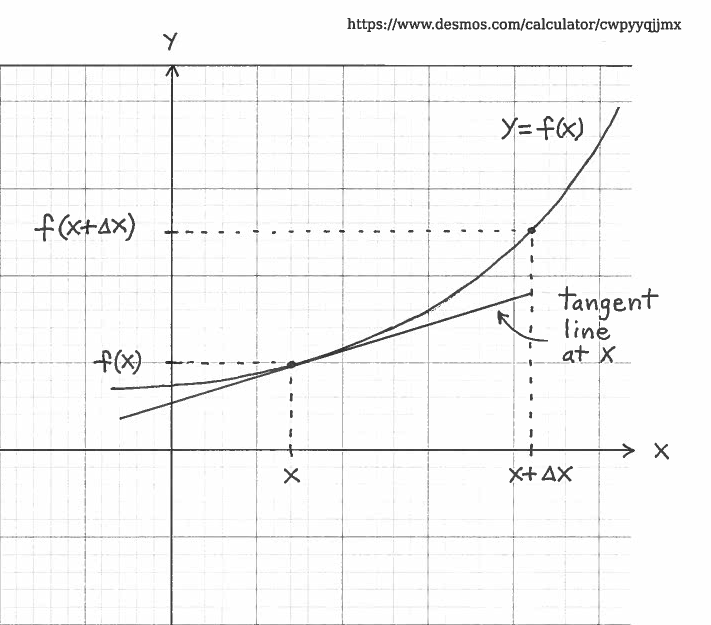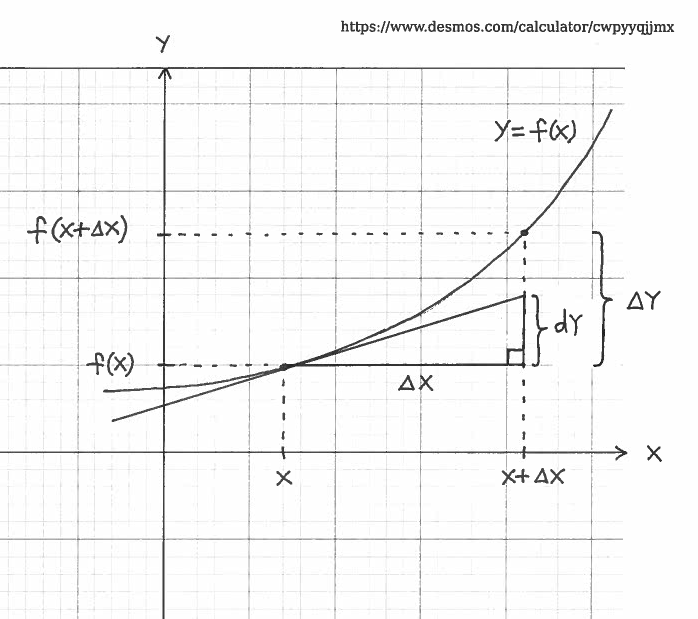Solving Differentials Problems
The following problems involve the concept of the Differential of a Function. I will introduce the Differential via it's geometric interpretation and then formulate it. For a function $ y=f(x) $ it will be shown that Differentials can be used to estimate the change of $y-$values as a function of a change in $x$-values. We will use Differentials to solve three types of problems. Differentials will be used to
$ \ \ \ \ \ $ I.) estimate the value of a numerical expression.
$ \ \ \ \ $ II.) approximate a relatively complicated functional expression with a simpler polynomial expression.
$ \ \ \ $ III.) estimate the propagation of percentage errors.
Let's begin with the graph of a function $y=f(x)$ and consider $x-$values changing from $x$ to $x+ \Delta x$, where $ \Delta x$ will be used to represent a small positive or negative change in $x$. I will refer to $x$ as the "starting" $x-$value and to $x + \Delta x$ as the second $x-$value. Draw a tangent line to this graph at $x$.

Since $x-$values change from $x$ to $x+ \Delta x$, the corresponding $y-$values will change from $ f(x) $ to $ f(x + \Delta x) $. Define this exact change in $y$-values to be $ \Delta y $, where
$$ \Delta y = f(x + \Delta x) - f(x) $$
We can now geometrically define this so-called Differential of $f(x)$. We will denote the Differential by $ dy $. It is the HEIGHT of the designated right triangle formed by $x$, $x+ \Delta x$, and the tangent line to the graph of $y=f(x)$ at $x$ in the following diagram:

Let's find a formula for $ dy$. Recall from algebra that the SLOPE of this tangent line at $x$ is
$$ m = \displaystyle{ rise \over run } = \displaystyle{ dy \over \Delta x } $$
Recall also that the SLOPE of this tangent line at $x$ is the derivative
$$ m=f'(x) $$
Setting these slopes equal to each other gives us
$$ \displaystyle{ dy \over \Delta x } = f'(x) $$
so that the Differential of Function $f$ at $x$ is
$$ dy = f'(x) \ \Delta x $$
Let's now verify that the Exact Change of $ \ y=f(x) \ $ is approximately equal to the Differential of $ \ y=f(x) \ $ for "small" $ \Delta x $, i.e.,
$$ \Delta y \approx dy $$
for small $ \Delta x $. Recall that the Derivative of $f$ at $x$ is
$$ \displaystyle{ \lim_{ \Delta x \to 0 } { f(x + \Delta x) - f(x) \over \Delta x } } = f'(x) \ \ \ \ \longrightarrow $$
$$ \displaystyle{ { f(x + \Delta x) - f(x) \over \Delta x } } \approx f'(x) \ \ \ \ \longrightarrow $$
for "small" $ \Delta x$
$$ \displaystyle{ { \Delta y \over \Delta x } } \approx f'(x) \ \ \ \ \longrightarrow $$
$$ \Delta y \approx f'(x) \ \Delta x \ \ \ \ \longrightarrow $$
$$ \Delta y \approx dy $$
for "small" $ \Delta x $.
Here is a summary of Differentials facts.
$ \ \ \ \ $ 1. Differentials require a function, $ y=f(x)$.
$ \ \ \ \ $ 2. Differentials require two $x-$values, written as $ \ x-$values: $x \ \rightarrow x + \Delta x $, where $x$ is denoted as the "starting" $x-$value and $ \Delta x$ can be positive or negative.
$ \ \ \ \ $ 3. The Exact Change in $y-$values is $ \ \Delta y = f(x+ \Delta x)- f(x) $.
$ \ \ \ \ $ 4. The Differential formula is $ \ dy = f'(x) \ \Delta x $, where $x$ is the "starting" $x-$value.
$ \ \ \ \ $ 5. We will assume that $ \ \Delta y \approx dy \ $ if $ \Delta x $ is "small."
In the list of Differentials Problems which follows, most problems are average and a few are somewhat challenging.
CATEGORY I-- Using Differentials to Estimate the Value of a Numerical Expression
- PROBLEM 1 : Use a Differential to estimate the value of $ \ \sqrt{28} $.
Click HERE to see a detailed solution to problem 1.
- PROBLEM 2 : Use a Differential to estimate the value of $ \ 10^{1/3} $.
Click HERE to see a detailed solution to problem 2.
- PROBLEM 3 : Use a Differential to estimate the value of $ \ \sqrt{96} $.
Click HERE to see a detailed solution to problem 3.
- PROBLEM 4 : Use a Differential to estimate the value of $ \ 14^{3/4} $.
Click HERE to see a detailed solution to problem 4.
- PROBLEM 5 : Use a Differential to estimate the value of $ \ \sqrt{72} $.
$ \ \ \ $ a.) Use 64 as a "starting" $x-$value.
$ \ \ \ $ b.) Use 81 as a "starting" $x-$value.
Click HERE to see a detailed solution to problem 5.
- PROBLEM 6 : Use a Differential to estimate the value of $ \ e^{-0.3} $.
Click HERE to see a detailed solution to problem 6.
- PROBLEM 7 : Use a Differential to estimate the value of $ \ \ln(1.2) $.
Click HERE to see a detailed solution to problem 7.
- PROBLEM 8 : Use a Differential to estimate the value of $ \ 30^{2/5} $.
Click HERE to see a detailed solution to problem 8.
- PROBLEM 9 : Use a Differential to estimate the value of $ \ \tan( \displaystyle{ \pi \over 4 } + 0.15) $.
Click HERE to see a detailed solution to problem 9.
- PROBLEM 10 : Use a Differential to estimate the value of $ \ \sin( \displaystyle{ \pi \over 6 } - 0.09) $.
Click HERE to see a detailed solution to problem 10.
- PROBLEM 11 : Use a Differential to estimate the value of $ \ \arctan(1.1) $.
Click HERE to see a detailed solution to problem 11.
- PROBLEM 12 : Use a Differential to estimate the value of $ \ \arcsin(0.45) $.
Click HERE to see a detailed solution to problem 12.
- PROBLEM 13 : Use a Differential to estimate the value of $ \ \arcsin(0.12) $.
Click HERE to see a detailed solution to problem 13.
CATEGORY II-- Using Differentials to Approximate a Relatively Complicated Functional Expression with a Simpler Polynomial Expression
- PROBLEM 14 : Use a Differential to verify the following statement: $ \ \ \ \ \sqrt{ 16+3h } \approx 4+ \displaystyle{ 3 \over 8 }h \ \ $ for "small" $h$
Click HERE to see a detailed solution to problem 14.
- PROBLEM 15 : Use a Differential to verify the following statement: $ \ \ \ \ \displaystyle{ h^2 \over 4+h^2 } \approx \displaystyle{ 1 \over 4 }h^2 \ \ $ for "small" $h$
Click HERE to see a detailed solution to problem 15.
- PROBLEM 16 : Use a Differential to verify the following statement: $ \ \ \ \ (8+5h^3)^{1/3} \approx 2+\displaystyle{ 5 \over 12 }h^3 \ \ $ for "small" $h$
Click HERE to see a detailed solution to problem 16.
- PROBLEM 17 : Use a Differential to verify the following statement: $ \ \ \ \ \ln(4+7h) \approx \ln(4)+\displaystyle{ 7 \over 4 }h \ \ $ for "small" $h$
Click HERE to see a detailed solution to problem 17.
- PROBLEM 18 : Use a Differential to verify the following statement: $ \ \ \ \ \log(100-h^4) \approx 2 - \displaystyle{ 1 \over 100 \ln(10) }h \ \ $ for "small" $h$
Click HERE to see a detailed solution to problem 18.
- PROBLEM 19 : Use a Differential to verify the following statement: $ \ \ \ \ \sqrt{ 25+h^3-h^2 } \approx 5+ \displaystyle{ 1 \over 10 }h^3 - \displaystyle{ 1 \over 10 }h^2 \ \ $ for "small" $h$
Click HERE to see a detailed solution to problem 19.
- PROBLEM 20 : Use a Differential to verify the following statement: $ \ \ \ \ \displaystyle{ 1 \over
\sqrt{ 1-h^2 } } \approx 1 + \displaystyle{ 1 \over 2 }h^2 \ \ $ for "small" $h$
Click HERE to see a detailed solution to problem 20.
- PROBLEM 21 : Use a Differential to verify the following statement: $ \ \ \ \ \displaystyle{ 8-h^2 \over (1+h^2)^2 } \approx 8-17h^2 \ \ $ for "small" $h$
Click HERE to see a detailed solution to problem 21.
CATEGORY II-- Using Differentials to Approximate the Percentage Errors
For the following problems we will refer to $ |\Delta x| $ as the "absolute error in $x$ and to $ |\Delta y| $ as the "absolute error in $y$. We will define $ \displaystyle{ |\Delta x| \over x } $ to be the "absolute percentage error in $x$" and $ \displaystyle{ |\Delta y| \over y } $ to be the "absolute percentage error in $y$". For example, if $ \Delta x= -0.4 $ and $x=20$, then the absolute percentage error in $x$ is
$$ \displaystyle{ |-0.4| \over 20 }= { 0.4 \over 20 } = { 0.4 \over 20 }{ 5 \over 5} = { 2 \over 100 } = 2\% $$
CATEGORY III-- Miscellaneous Differential Problems
Click HERE to return to the original list of various types of calculus problems.
Your comments and suggestions are welcome. Please e-mail any correspondence to Duane Kouba by
clicking on the following address :
kouba@math.ucdavis.edu
A heartfelt "Thank you" goes to The MathJax Consortium for making the construction of this webpage fun and easy.
Duane Kouba ...
October 24, 2019


